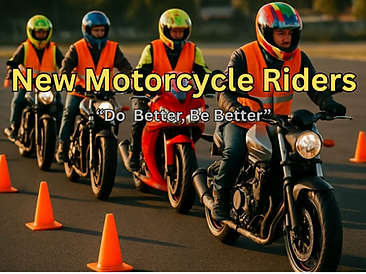Top Dangers Motorcycle Riders Face and How to Prevent Them
- NMR

- 2 days ago
- 3 min read
Riding a motorcycle offers freedom and excitement, but it also comes with serious risks. Motorcycle riders face dangers that can lead to severe injuries or worse. Understanding these risks and knowing how to avoid them can make every ride safer and more enjoyable. This post explores the top dangers motorcycle riders encounter and practical steps to prevent or reduce these risks.

Risk of Collisions with Other Vehicles
One of the most common dangers for motorcycle riders is collisions with cars and trucks. Motorcycles are smaller and less visible, which often leads to other drivers not noticing them. This can result in accidents, especially at intersections or when vehicles change lanes without checking blind spots.
How to Prevent Collisions
Stay visible: Wear bright or reflective clothing and use your headlights even during the day.
Position yourself well: Ride in a lane position where you are most visible to other drivers.
Be cautious at intersections: Slow down and scan for vehicles that might turn or cross your path.
Avoid blind spots: Never linger in other vehicles’ blind spots; adjust your position to stay visible.
Road Hazards and Poor Surface Conditions
Motorcycles are more vulnerable to road hazards like potholes, gravel, wet leaves, oil spills, and uneven pavement. These can cause loss of control and crashes.
How to Avoid Road Hazards
Scan the road ahead: Constantly look for debris, potholes, or slick spots.
Adjust speed: Slow down when approaching questionable road surfaces.
Use proper tires: Ensure your tires are in good condition and suited for the terrain.
Practice emergency maneuvers: Learn how to safely swerve or brake on slippery surfaces.
Weather Conditions
Rain, fog, wind, and cold temperatures can all increase the risk of accidents. Wet roads reduce traction, fog lowers visibility, and strong winds can destabilize a motorcycle.
How to Ride Safely in Bad Weather
Wear appropriate gear: Waterproof and windproof clothing helps maintain comfort and focus.
Increase following distance: Give yourself more space to react.
Reduce speed: Ride slower to maintain control.
Avoid sudden moves: Smooth acceleration, braking, and steering reduce the chance of skidding.
Speeding and Aggressive Riding
Speeding increases the chance of losing control and reduces the time to react to hazards. Aggressive riding, such as weaving through traffic or tailgating, raises the risk of crashes.
How to Control Speed and Riding Style
Follow speed limits: They are designed for safety.
Stay calm: Avoid aggressive maneuvers even if other drivers are impatient.
Plan your route: Choose roads with less traffic or fewer hazards.
Take breaks: Fatigue can lead to poor decisions and slower reactions.
Lack of Protective Gear
Not wearing proper protective gear greatly increases the severity of injuries in a crash. Helmets, jackets, gloves, and boots protect vital areas of the body.
Essential Protective Gear
Helmet: Always wear a DOT-approved helmet to protect your head.
Jacket and pants: Use abrasion-resistant materials with armor padding.
Gloves: Protect your hands from impact and abrasion.
Boots: Cover ankles and provide good grip on foot controls.
Inexperience and Lack of Training
New riders or those who have not taken formal training are more likely to make mistakes that lead to accidents. Understanding motorcycle dynamics and practicing skills is crucial.
How to Gain Experience Safely
Take a motorcycle safety course: Learn essential skills and safety tips.
Practice regularly: Build confidence in different conditions.
Ride within your limits: Avoid challenging roads or traffic until you are ready.
Stay updated: Refresh your skills and knowledge periodically.
Fatigue and Distraction
Riding while tired or distracted reduces focus and reaction time. This can lead to missing hazards or making poor decisions.
How to Stay Focused
Get enough rest: Avoid riding when you feel tired.
Limit distractions: Do not use phones or other devices while riding.
Stay hydrated and nourished: Keep your energy levels up.
Take breaks: Stop every hour or so to stretch and refresh.
Mechanical Failures
Motorcycle breakdowns or failures can cause accidents if they happen suddenly while riding.
How to Maintain Your Motorcycle
Regular inspections: Check brakes, tires, lights, and fluid levels before every ride.
Follow maintenance schedules: Replace worn parts promptly.
Listen for unusual sounds: Address any strange noises or handling issues immediately.
Carry basic tools: Be prepared for minor repairs on the road.
Thank you for reading this article. Please leave us a like a comment below. Your feedback helps us with content you want to see.





.png)



Comments